【弯道超车】2025年人教PEP版六年级英语上册暑假预习 Unit 2 Ways to go to school(含答案解析)
文档属性
| 名称 | 【弯道超车】2025年人教PEP版六年级英语上册暑假预习 Unit 2 Ways to go to school(含答案解析) | 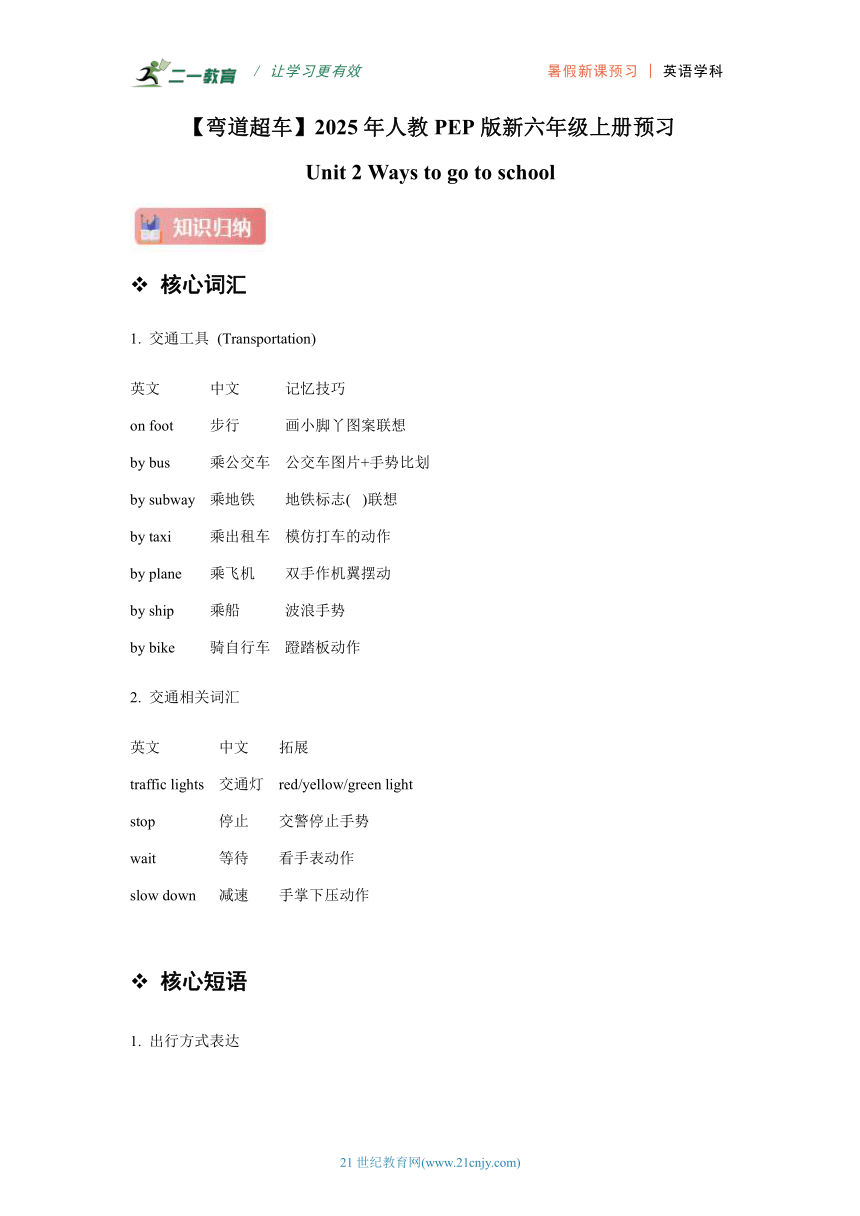 | |
| 格式 | docx | ||
| 文件大小 | 374.5KB | ||
| 资源类型 | 试卷 | ||
| 版本资源 | 人教版(PEP) | ||
| 科目 | 英语 | ||
| 更新时间 | 2025-07-01 18:58:01 | ||
图片预览

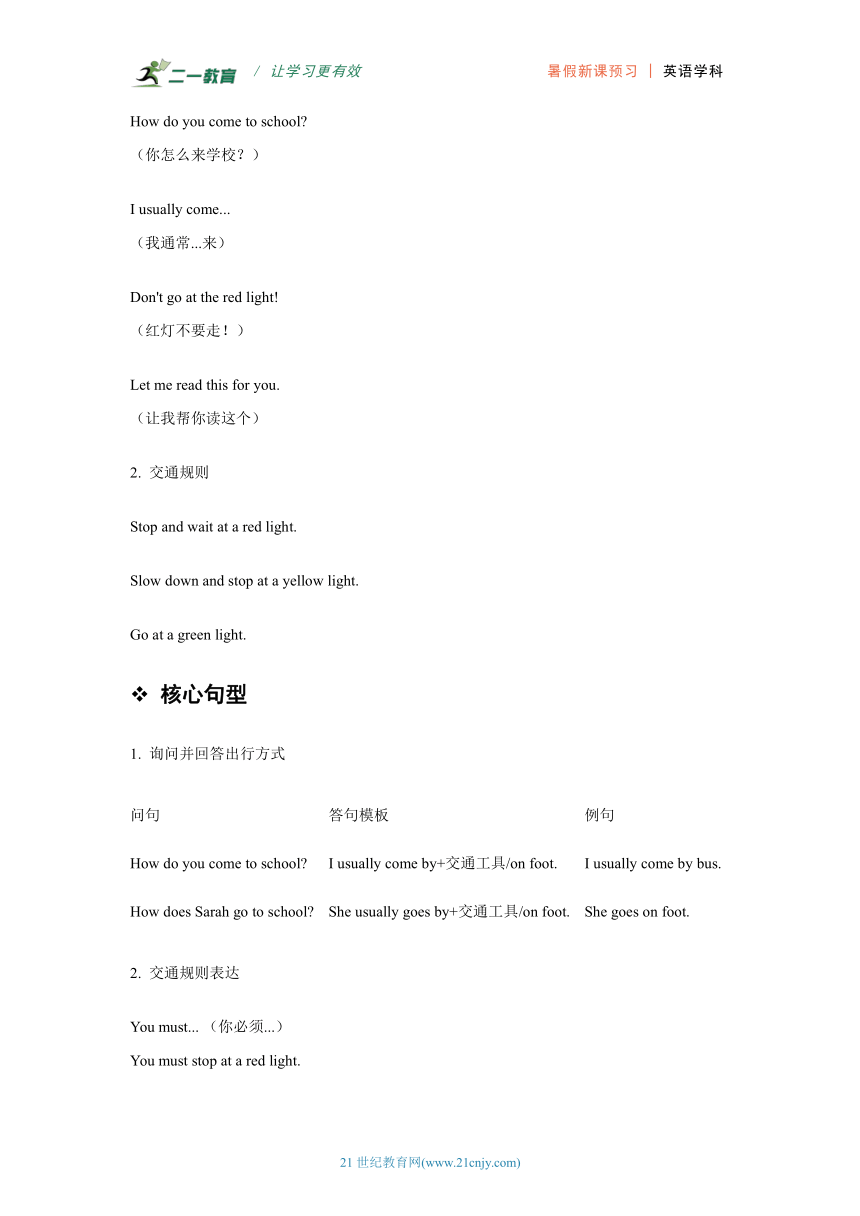
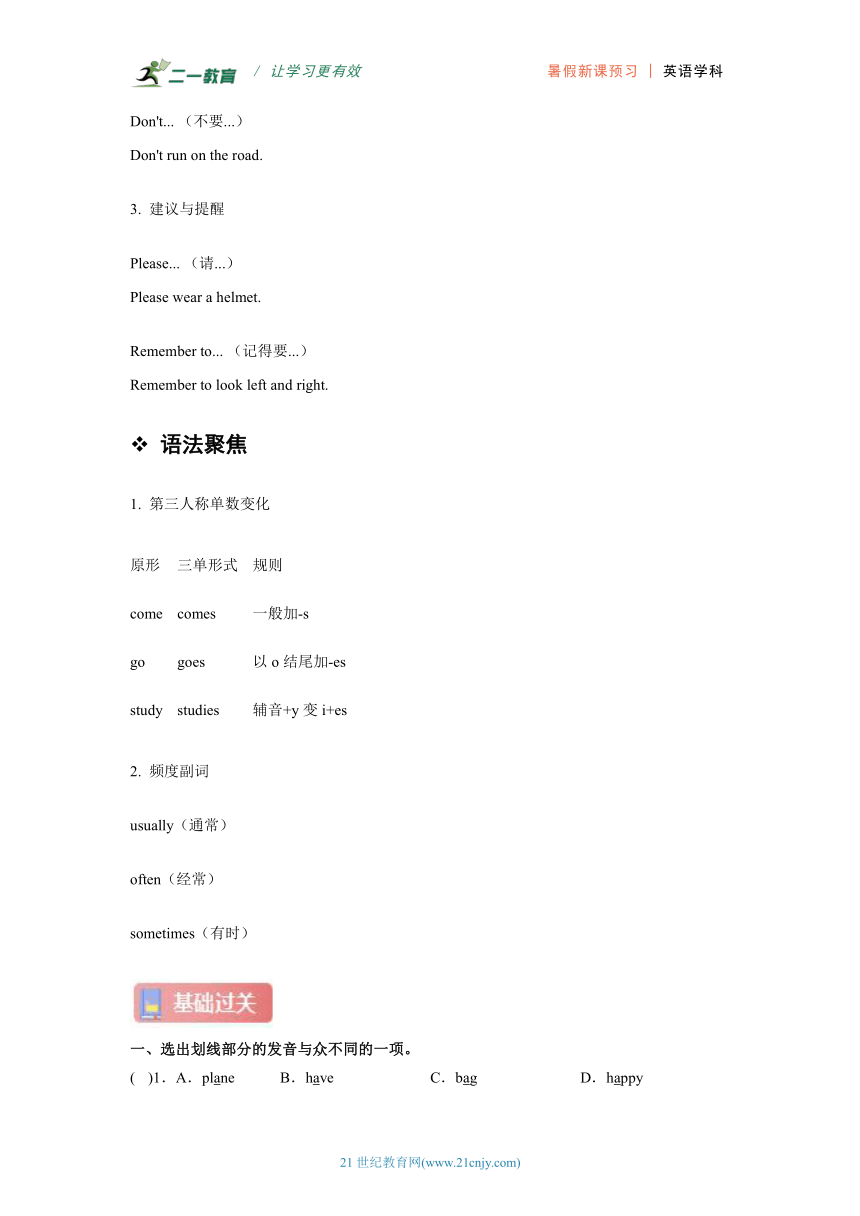
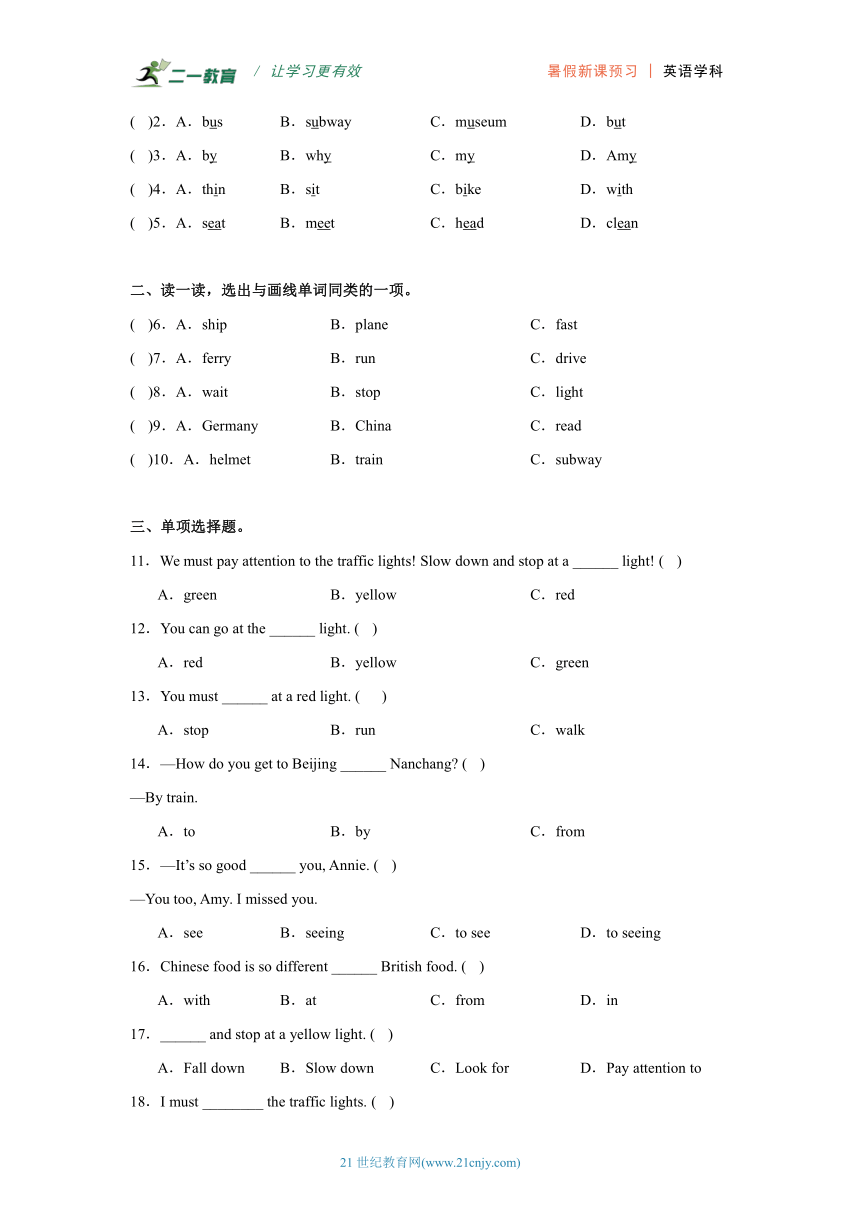
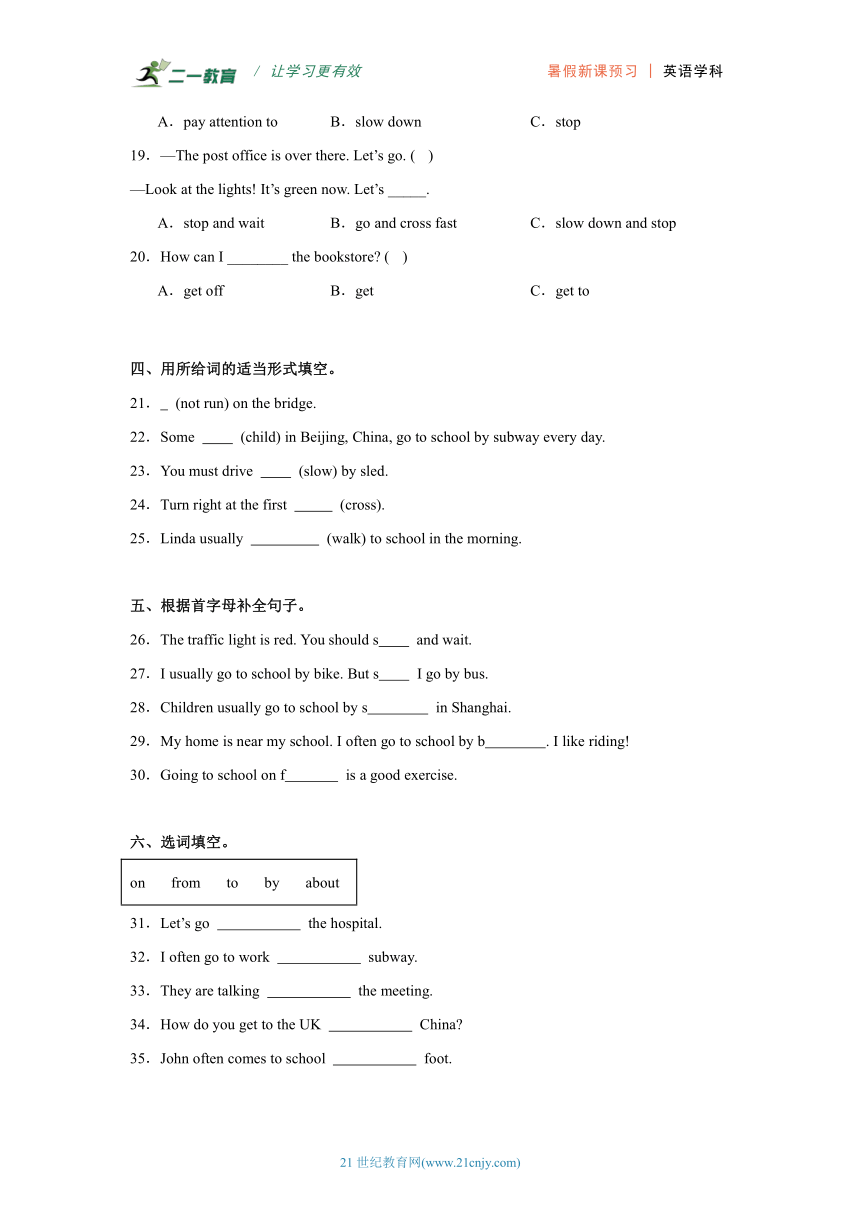
文档简介
/ 让学习更有效 暑假新课预习 | 英语学科
/ 让学习更有效 暑假新课预习 | 英语学科
【弯道超车】2025年人教PEP版新六年级上册预习
Unit 2 Ways to go to school
核心词汇
1. 交通工具 (Transportation)
英文 中文 记忆技巧
on foot 步行 画小脚丫图案联想
by bus 乘公交车 公交车图片+手势比划
by subway 乘地铁 地铁标志( )联想
by taxi 乘出租车 模仿打车的动作
by plane 乘飞机 双手作机翼摆动
by ship 乘船 波浪手势
by bike 骑自行车 蹬踏板动作
2. 交通相关词汇
英文 中文 拓展
traffic lights 交通灯 red/yellow/green light
stop 停止 交警停止手势
wait 等待 看手表动作
slow down 减速 手掌下压动作
核心短语
1. 出行方式表达
How do you come to school
(你怎么来学校?)
I usually come...
(我通常...来)
Don't go at the red light!
(红灯不要走!)
Let me read this for you.
(让我帮你读这个)
2. 交通规则
Stop and wait at a red light.
Slow down and stop at a yellow light.
Go at a green light.
核心句型
1. 询问并回答出行方式
问句 答句模板 例句
How do you come to school I usually come by+交通工具/on foot. I usually come by bus.
How does Sarah go to school She usually goes by+交通工具/on foot. She goes on foot.
2. 交通规则表达
You must... (你必须...)
You must stop at a red light.
Don't... (不要...)
Don't run on the road.
3. 建议与提醒
Please... (请...)
Please wear a helmet.
Remember to... (记得要...)
Remember to look left and right.
语法聚焦
1. 第三人称单数变化
原形 三单形式 规则
come comes 一般加-s
go goes 以o结尾加-es
study studies 辅音+y变i+es
2. 频度副词
usually(通常)
often(经常)
sometimes(有时)
一、选出划线部分的发音与众不同的一项。
( )1.A.plane B.have C.bag D.happy
( )2.A.bus B.subway C.museum D.but
( )3.A.by B.why C.my D.Amy
( )4.A.thin B.sit C.bike D.with
( )5.A.seat B.meet C.head D.clean
二、读一读,选出与画线单词同类的一项。
( )6.A.ship B.plane C.fast
( )7.A.ferry B.run C.drive
( )8.A.wait B.stop C.light
( )9.A.Germany B.China C.read
( )10.A.helmet B.train C.subway
三、单项选择题。
11.We must pay attention to the traffic lights! Slow down and stop at a ______ light! ( )
A.green B.yellow C.red
12.You can go at the ______ light. ( )
A.red B.yellow C.green
13.You must ______ at a red light. ( )
A.stop B.run C.walk
14.—How do you get to Beijing ______ Nanchang ( )
—By train.
A.to B.by C.from
15.—It’s so good ______ you, Annie. ( )
—You too, Amy. I missed you.
A.see B.seeing C.to see D.to seeing
16.Chinese food is so different ______ British food. ( )
A.with B.at C.from D.in
17.______ and stop at a yellow light. ( )
A.Fall down B.Slow down C.Look for D.Pay attention to
18.I must ________ the traffic lights. ( )
A.pay attention to B.slow down C.stop
19.—The post office is over there. Let’s go. ( )
—Look at the lights! It’s green now. Let’s _____.
A.stop and wait B.go and cross fast C.slow down and stop
20.How can I ________ the bookstore ( )
A.get off B.get C.get to
四、用所给词的适当形式填空。
21. (not run) on the bridge.
22.Some (child) in Beijing, China, go to school by subway every day.
23.You must drive (slow) by sled.
24.Turn right at the first (cross).
25.Linda usually (walk) to school in the morning.
五、根据首字母补全句子。
26.The traffic light is red. You should s and wait.
27.I usually go to school by bike. But s I go by bus.
28.Children usually go to school by s in Shanghai.
29.My home is near my school. I often go to school by b . I like riding!
30.Going to school on f is a good exercise.
六、选词填空。
on from to by about
31.Let’s go the hospital.
32.I often go to work subway.
33.They are talking the meeting.
34.How do you get to the UK China
35.John often comes to school foot.
七、看图完成句子。
36.—How do you go to Shandong
—I go there by .
37.There are three traffic .
38.It means .
39.My dad usually goes to work by s .
40.We can take it to school. It’s fast than a bus. It’s a .
八、英汉互译。
41.没有,我感冒了。整个周末都待在家里睡觉。
42.I must pay attention to the traffic lights!
43.How do you get to China from Canada
44.让我们乘出租车去动物园吧。
45.Sometimes Jim goes to school by bus.
九、连词成句。
46.to, lights, attention, the, must, traffic, we, pay (.)
47.must, attention, lights, I, pay, to, the, traffic (!)
48.on, don’t, subway, run, the (.)
49.he, does, go, how, school, to ( )
50.left, at, the, turn, cinema (.)
十、句型转换
51.He walked to school yesterday. (改为同义句)
He went to school yesterday.
52.Wait! Don’t go at a red light! (根据实际情况用英文简短回答)
53.How can I get to the museum (改变划线部分仿写新句子)
54.Sometimes I come by bus. (改为一般疑问句)
sometimes come by bus
55.Go to the zoo. (改否定句)
to the zoo.
十一、完形填空。
Some children 56 to school on foot in Munich, Germany. They must 57 . Some children in Jiangxi, China, go to school by ferry every day. That sounds interesting. In Alaska, USA, it snows a lot. Some kids go to school by sled. It’s fast. They should not 58 . In Tokyo, Japan, some children go to school by school bus. They should not 59 . In my class in Jinan, most of us go to school by electric bike, and it’s environmental (环保的) . I go to school 60 , because my home is near, and it’s healthy, too.
( )56.A.Go B.goes C.going
( )57.A.run fast B.wear warm clothes C.pay attention to the traffic lights
( )58.A.drive slowly B.stop and wait C.let the dogs run too fast
( )59.A.talk quietly B.take turns C.run on the bus
( )60.A.on foot B.by plane C.by train
十二、阅读理解。
(A)
阅读短文,根据短文内容判断句子正(T)误(F)。
The traffic lights are the same in every country. There are always three lights—red, yellow and green. Red means “Stop and wait!” Yellow means “Slow down and stop!” Green means “Go!” In the USA, people drive on the right side. But in the UK and Australia, people drive on the left side. If (如果) you go by car, by bike or on foot, you must pay attention to the traffic rules.
61.The traffic lights are red, yellow and blue. ( )
62.The yellow light means “Slow down and stop!” ( )
63.In the USA, drivers drive on the left side of the road. ( )
64.In Australia,drivers drive on the right side of the road. ( )
65.If you go on foot, you don’t have to pay attention to the traffic rules. ( )
(B)
阅读短文,选择正确的答案。
I’m Sarah. I live in a big city. Usually my father goes to work by car. He likes driving, but he doesn’t like driving to work. Why Because it takes too much time. There is always a lot of traffic. His car is very slow. He goes home very late every day. And he is very tired. He doesn’t like playing with me after work.
Today, he is happy, “There is going to be a train near our home! I am going to work by subway next year. It is fast. I can read newspapers on the train. I can listen to music, too!” My mom says, “Then you can come back early and cook the meals.” I say, “You can play with me after work.”
66.How is Sarah’s father going to go to work next year ( )
A.He is going to go to work by bus.
B.He is going to go to work by car.
C.He is going to go to work by subway.
67.Sarah’s father doesn’t like driving to work. Why ( )
A.Because the traffic is too busy.
B.Because his car is too fast.
C.Because his home is near.
68.Does Sarah’s father cook dinner after work ( )
A.Yes, he does. B.No, he doesn’t. C.No, he isn’t.
69.Does Sarah live in a big city ( )
A.Yes, she does. B.No, she doesn’t. C.Yes, she is.
70.Is Sarah’s father going to come back early next year ( )
A.Yes, he is. B.Yes, he does. C.No, he doesn’t.
(C)
阅读短文,完成下列各题。
When you are in England, you must be careful(小心) in the street. Because the drivers drive on the left. Before you cross a street, you must look right, then left. When you go go by bus in England, you have to be careful, too. Always remember the traffic moves on the left. In the morning and evening when people go to or come from work, the streets are very busy. In many England cities. there are big buses with two floors. They are very helpful for people.
71.The drivers drive on the right in England. ( )
72.You must look left first when you cross the street in England. ( )
73.The streets are very busy in the morning and evening. ( )
74.You must remember the traffic moves on the left. ( )
75.There are big buses with two floors in many England cities. “floor” means _____. ( )
A.地板 B.层 C.窗户
十三、书面表达。
76.假设你是 Amy,你和你的朋友们怎样去上学?步行、乘公共汽车,还是坐地铁?你们为什么选择这种方式?你们会注意 (pay attention to) 路边的交通信号灯 (traffic lights) 吗? 请以“Ways to go to school”为题,写一篇短文,介绍一下你们的上学方式吧!
要求: (1). 紧扣主题,意思连贯,语言通顺,书写规范。
(2). 不少于 50 词。
Ways to go to school
______________________________________________________________________________________________________________________________________________________________
______________________________________________________________________________________________________________________________________________________________
______________________________________________________________________________________________________________________________________________________________
______________________________________________________________________________________________________________________________________________________________
/ 让学习更有效 暑假新课预习 | 英语学科
/ 让学习更有效 暑假新课预习 | 英语学科
______________________________________________________________________________________________________________________________________________________________21世纪教育网(www.21cnjy.com)
21世纪教育网(www.21cnjy.com)
参考答案及试题解析
1.A 2.C 3.D 4.C 5.C
【解析】1.选项BCD划线部分的发音为[ ],选项A划线部分的发音为[e ],所以A不同,故选A。
2.选项ABD划线部分的发音为[ ],选项C划线部分的发音为[ju],所以C不同,故选C。
3.选项ABC划线部分的发音为[a ],选项D划线部分的发音为[ ],所以D不同,故选D。
4.选项ABD划线部分的发音为[ ],选项C划线部分的发音为[a ],所以C不同,故选C。
5.选项ABD划线部分的发音为[i:],选项C划线部分的发音为[e],所以C不同,故选C。
6.C 7.A 8.C 9.C 10.A
【解析】6.A轮船,B飞机,C快的。A和B是交通工具名词,C是形容词,故选C。
7.A轮渡,B跑,C驾驶。A是名词,B和C都是动词,故选A。
8.A等待,B停止,C灯。A和B都是动词,C是名词,故选C。
9.A德国,B中国,C读。A和B都是国家名词,C是动词,故选C。
10.A头盔,B火车,C地铁。B和C都是交通工具名词,A是物品名词,故选A。
11.C
【解析】句意:我们必须注意交通灯!在红灯处减速并停下来!本题考查形容词辨析。A绿色的,B黄色的,C红色的,根据题干说减速并停下来,可知是红灯,故选C。
12.C
【解析】句意:你可以在绿灯时通行。本题考查形容词辨析。A红色的,B黄色的,C绿色的绿灯表示允许通行,红灯和黄灯分别表示停止和等待。故选C。
13.A
【解析】句意:红灯时你必须停下。本题考查动词辨析。A停,B跑,C走路。根据交通规则,红灯时应停止前进,故选A。
14.C
【解析】句意:—你从南昌怎么到北京?—坐火车。本题考查介词辨析。询问从某地到某地的交通方式时,用from表示起点,to表示终点。题干中Beijing是终点,Nanchang是起点,故空格处应填from。A到,B乘坐,不符合句意。故选C。
15.C
【解析】句意:—见到你真好,安妮。—你也是,Amy,我想你了。本题考查动词的形式。A是动词原形,B是动词的现在分词或者动名词,C是动词不定式,D是to+动名词,句型“It’s good/nice + to do”表示“做某事是好的/愉快的”,动词需用不定式形式。故选C。
16.C
【解析】句意:中国食物与英国食物大不相同。本题考查介词的固定搭配。be different from与……不同,是固定用法,符合句意,故选C。
17.B
【解析】句意:黄灯时要减速并停下。本题考查动词短语。A跌倒,B减速,C寻找,D注意,黄灯时正确的做法是减速(slow down)并准备停车。选项B“Slow down”符合语境,且与“stop”由and连接,构成并列的祈使句结构,无需宾语。故选B。
18.A
【解析】句意:我必须注意交通灯。本题考查动词和动词短语的辨析。A注意,B减速,C停止,选项A符合句意,故选A。
19.B
【解析】句意:—邮局在那里。让我们去吧。—看交通灯!它现在是绿色。让我们快点通过。本题考查动词短语。A停下并且等待,B快点走,C减速并且停下,根据“It’s green now. L”可知绿灯时可以通过,故选B。
20.C
【解析】句意:我怎么到书店?本题考查动词和动词短语的辨析。A下车,B得到,C到达,选项C符合句意,故选C。
21.
Don’t run
【解析】句意:不要在桥上跑。本题考查祈使句的否定形式。祈使句的否定结构为“Don’t + 动词原形+其他。”,用于表达禁止或劝告。故答案为Don’t run。
22.
children
【解析】句意:在中国北京,一些孩子每天乘地铁上学。本题考查可数名词及其单复数。some后接可数名词复数,child的复数形式为不规则变化的children。故答案为children。
23.
slowly
【解析】句意:你必须用雪橇缓慢驾驶。本题考查副词的用法。括号中给出的词是形容词,该空应用副词修饰动词drive,slow的副词是slowly。故答案为slowly。
24.crossing
【解析】句意:在第一个十字路口右转。本题考查可数名词及其单复数。cross穿过,动词,该处用名词crossing十字路口,根据first可知用单数。故答案为crossing。
25.
【解析】句意:琳达通常早上步行去学校。本题考查动词的形式。根据句意可知句子是一般现在时,主语Linda是第三人称单数,walk用第三人称单数形式walks,故答案为。
26.stop/top
【解析】句意:现在是红灯。你应该停下来等。本题考查动词的形式。根据句意及首字母,可知单词为stop停,should后跟动词原形,故答案为stop。
27.sometimes/ometimes
【解析】句意:我通常骑自行车去上学。但有时我坐公交车去。本题考查频度副词。根据句意及首字母,可知单词为sometimes有时,故答案为sometimes。
28.subway/ubway
【解析】句意:在上海,孩子们通常乘地铁上学。本题考查介词固定搭配。根据句意及首字母,可知搭配为by subway乘地铁,故答案为subway。
29.bike
【解析】句意:我家离我的学校很近。我经常骑自行车去上学。我喜欢骑自行车。本题考查介词固定搭配,根据句意及首字母,可知搭配为by bike骑自行车,故答案为bike。
30.foot/oot
【解析】句意:步行去学校是很好的锻炼。本题考查介词固定搭配。根据句意及所给字母可知考查单词foot,on foot步行,故答案为foot。
31.to 32.by 33.about 34.from 35.on
【解析】31.句意:让我们去医院吧。to去,go to the hospital去医院,动词短语,故答案为to。
32.句意:我经常坐地铁去上班。by乘坐,by subway乘坐地铁,介词固定搭配,故答案为by。
33.句意:他们正在谈论会议。about关于,talk bout谈论,动词短语,故答案为about。
34.句意:你从中国怎么去英国?from从,符合题意,故答案为from。
35.句意:约翰经常步行来学校。on foot走路;步行,介词固定搭配,故答案为on。
36.train
【解析】句意:—你怎么去山东?—我坐火车去那里、本题考查介词固定搭配,根据图片,可知搭配为by train坐火车,故答案为train。
37.lights
【解析】句意:有三个交通灯。本题考查名词词组和可数名词及其单复数。根据句意及图片,可知词组为traffic light交通灯,前面有three修饰,用复数traffic lights,故答案为lights。
38.turning left
【解析】句意:它意思是向左转。本题考查动词短语和动词的形式,图片是向左转turn left,mean doing sth意思是……,动词用动名词,turn的动名词是turning,故答案为turning left。
39.subway/ubway
【解析】句意:我的爸爸通常乘地铁去上班。本题考查介词固定搭配。根据图片可知是by subway乘地铁,故答案为subway。
40.taxi
【解析】句意:我们可以坐它去学校。它比公共汽车快。它是一辆______。本题考查可数名词及其单复数。图中是出租车taxi,前面有a修饰,用单数,故答案为taxi。
41.
【解析】本题考查句子翻译。根据汉语意思可知句子是陈述句的肯定形式,时态是一般过去时,没有No,我I,感冒have a cold,动词have的过去式是had,待在家里stay at home,stay用过去式stayed,和and,睡觉sleep,过去式是slept,整个周末all weekend,故答案为。
42.我必须要注意交通信号灯!
【解析】本题考查句子翻译。I我,must必须,pay attention to注意,the traffic lights交通信号灯,句子是陈述句,故答案为我必须要注意交通信号灯!
43.你怎么从加拿大到中国?
【解析】本题考查句子翻译。How怎样,do助动词,you你,get to到达,China中国,from从,Canada加拿大,句子是特殊疑问句,故答案为你怎么从加拿大到中国?
44.Let’s go to the zoo by taxi.
【解析】本题考查句子翻译。根据汉语意思可知句子是祈使句。让我们let’s ,乘出租车by taxi,去动物园go to the zoo,故答案为Let’s go to the zoo by taxi.
45.吉姆有时乘公共汽车去上学。
【解析】本题考查句子翻译。Sometimes有时,Jim吉姆,goes to school去上学,by bus坐公共汽车,句子是陈述句,故答案为吉姆有时乘公共汽车去上学。
46.We must pay attention to the traffic lights.
【解析】本题考查句子结构。pay attention to注意,the traffic lights交通灯,must必须,we我们,根据所给句号和单词,可知句子是陈述句,根据词义连成句子:我们必须注意交通灯。故答案为We must pay attention to the traffic lights.
47.I must pay attention to the traffic lights.
【解析】本题考查句子结构。must必须,pay attention to注意,the traffic lights交通灯,I我,根据所给感叹号和单词,可知句子是陈述句,根据词义连成句子:我必须注意交通灯。故答案为I must pay attention to the traffic lights.
48.
【解析】本题考查句子结构。on the subway在地铁上,don’t不要,run跑,根据所给句号和单词,可知句子是祈使句,根据词义连成句子:不要在地铁上跑。故答案为。
49.How does he go to school
【解析】本题考查句子结构。he他,does助动词,go to school去上学,how怎样。根据所给问号,可知句子是疑问句,根据词义连成句子:他怎样去上学?故答案为How does he go to school
50.Turn left at the cinema.
【解析】本题考查句子结构。turn left左转,at在,the cinema电影院。根据所给句号和单词,可知该句是祈使句的肯定形式。根据所给词义连成句子:在电影院左转。故答案为Turn left at the cinema.
51.on foot
【解析】原句句意:他昨天步行去学校。本题考查句型转换。题目要求改为同义句。walk走路,等于on foot,故答案为on,foot。
52.Sorry.
【解析】句意:等待!不要闯红灯!本题考查祈使句的答语。题干要求根据实际情况用英文简短回答,答语可为:对不起。Sorry. 故答案为Sorry.
53.
【解析】句意:我怎么去博物馆?本题考查句型转换,句子是疑问句,答案不唯一,划线部分是地点,可以改为动物园zoo,句意为:我怎么去动物园?故答案为。
54.Do you
【解析】句意:有时我乘公共汽车来。本题考查句型转换。句子是一般现在时,主语是I,变为疑问句时主语应改为you,一般疑问句助动词要用do。故答案为Do,you。
55.Don’t go
【解析】原句句意:去动物园。本题考查句型转换。根据句意,可知改为否定句的句意是:不要去动物园。该句是祈使句,变否定句在句首加don’t=do not不,去go。故答案为Don’t;go。
56.A 57.C 58.C 59.C 60.A
【导语】本文讲述了各国学生上学的方式。
56.句意:在德国慕尼黑,一些孩子步行去上学。A动词原形,B动词第三人称单数,C动名词。根据句意可知,此处是在陈述客观事实,时态应为一般现在时,主语为some children,谓语动词用原形,故选A。
57.句意:他们必须________。A快点跑,B穿暖和的衣服,C注意交通灯。上句说在德国慕尼黑,一些孩子步行去上学,可知他们应该注意交通灯,故选C。
58.句意:他们不应该________。A慢点驾驶,B停下并等候,C让狗跑得太快。根据文中“In Alaska, USA, it snows a lot. Some kids go to school by sled. It’s fast.”及句子逻辑可知,为了安全考虑,他们不应该让拉雪橇的狗跑得太快。故选C。
59.句意:她们不应该________。A安静的交谈,B按顺序轮流,C在校车上奔跑。根据文中“In Tokyo, Japan, some children go to school by school bus. ”及句子逻辑可知,为了安全考虑,他们不应该在校车上奔跑,故选C。
60.句意:我________去上学,因为我家很近,而且这种方式很健康。A步行,B乘飞机,C乘火车。根据文中“because my home is near, and it’s healthy, too.”可推断出作者应该是步行上学,故选A。
61.F 62.T 63.F 64.F 65.F
【导语】本文讲了交通规则。
61.句意:交通灯是红色,黄色和蓝色。根据“There are always three lights—red, yellow and green.”,可知交通灯是红色,黄色和绿色,故答案为F。
62.句意:黄灯的意思是“减速并停下来!”根据“Yellow means “Slow down and stop!””,可知题干与短文相符,故答案为T。
63.句意:在美国,司机靠左行驶。根据“In the USA, people drive on the right side.”,可知在美国,司机靠右行驶,故答案为F。
64.句意:在澳大利亚,司机靠右行驶。根据“But in the UK and Australia, people drive on the left side.”,可知在澳大利亚,司机靠左行驶,故答案为F。
65.句意:如果你步行,你就不必注意交通规则。根据“If (如果) you go by car, by bike or on foot, you must pay attention to the traffic rules.”,可知步行也要注意交通规则,故答案为F。
66.C 67.A 68.B 69.A 70.A
【导语】本文主要讲了莎拉的爸爸的出行方式以及对生活的影响。
66.句意:明年莎拉的爸爸将要如何去上班?A他将要乘公交车去上班。B他将要乘小汽车去上班。C他将要乘地铁去上班。根据文中“I am going to work by subway next year. ”可知,莎拉的爸爸明年将要乘地铁去上班,选项C符合题意,故选C。
67.句意:莎拉的爸爸不喜欢开车去上班。为什么?A因为交通拥堵。B因为汽车太快了。C因为他的家很近。根据文中“He likes driving, but he doesn’t like driving to work. Why Because it takes too much time. There is always a lot of traffic. His car is very slow. He goes home very late every day. ”可知,莎拉的爸爸不喜欢开车上班的原因是交通拥堵,汽车开的很慢,以至于使他每天都很晚回家,选项A符合题意,故选A。
68.句意:莎拉的爸爸下班后做晚餐吗?A是的,他做。B不,他不做。C不,他不是。根据文中“He goes home very late every day. And he is very tired.”可知,莎拉的爸爸每天回家很晚,并且非常累,没有时间做晚餐,选项B符合题意,故选B。
69.句意:莎拉住在一个大城市吗?A是的,她住在那里。B不,她不住那里。C是的,她是。根据文中“I’m Sarah. I live in a big city.”可知,莎拉住在一个大城市里,选项A符合题意,故选A。
70.句意:明年莎拉的爸爸将会回来早一点吗?A是的,他会。B是的,他做。C不,他不做。根据文中“My mom says, ‘Then you can come back early and cook the meals.’”可知,莎拉的爸爸明年会回来早一点,选项A符合题意,故选A。
71.F 72.F 73.T 74.T 75.B
【导语】本文主要讲了不同国家的交通规则。
71.句意:在英国,司机们靠右行驶。由“the drivers drive on the left.”可知,英国司机靠左行驶,题干与原文不符,故答案为F。
72.句意:在英国,当你穿过街道时,你必须先向左看。由“you must look right, then left.”可知,应该先向右看,然后再向左看,题干与原文不符,故答案为F。
73.句意:在早上和晚上街道都十分繁忙。由“In the morning and evening when people go to or come from work, the streets are very busy.”可知,早晚街道都很繁忙,题干与原文相符,故答案为T。
74.句意:你必须记住交通靠左。由“Always remember the traffic moves on the left.”可知,需要记住交通靠左,题干与原文相符,故答案为T。
75.句意:在英国的许多城市都有两层的公共汽车。由题意可知,floor在这里指的是公交车的层数,故选B。
76.范文:
Ways to go to school
I’m Amy. I often go to school by bus. It’s fast. Bob lives near the school. He usually walks to school. It’s good exercise. Peter likes riding his bike. He often goes to school by bike. Kate lives far from the school. She usually goes to school by subway. We always pay attention to the traffic lights.
【解析】1. 题干解读:该题目要求假如自己是Amy,以“Ways to go to school”为题,写一篇短文。然后再阐述自己和朋友上学的交通方式。注意文章为一般现在时态并要符合单词字数要求。
2. 参考词汇与句型:
参考单词:by bus坐公共汽车,walk to school步行去学校,by bike骑自行车,far from远离,by subway坐地铁,pay attention to注意
参考句型:I’m …; I often …;He/She …
21世纪教育网(www.21cnjy.com)
21世纪教育网(www.21cnjy.com)
/ 让学习更有效 暑假新课预习 | 英语学科
【弯道超车】2025年人教PEP版新六年级上册预习
Unit 2 Ways to go to school
核心词汇
1. 交通工具 (Transportation)
英文 中文 记忆技巧
on foot 步行 画小脚丫图案联想
by bus 乘公交车 公交车图片+手势比划
by subway 乘地铁 地铁标志( )联想
by taxi 乘出租车 模仿打车的动作
by plane 乘飞机 双手作机翼摆动
by ship 乘船 波浪手势
by bike 骑自行车 蹬踏板动作
2. 交通相关词汇
英文 中文 拓展
traffic lights 交通灯 red/yellow/green light
stop 停止 交警停止手势
wait 等待 看手表动作
slow down 减速 手掌下压动作
核心短语
1. 出行方式表达
How do you come to school
(你怎么来学校?)
I usually come...
(我通常...来)
Don't go at the red light!
(红灯不要走!)
Let me read this for you.
(让我帮你读这个)
2. 交通规则
Stop and wait at a red light.
Slow down and stop at a yellow light.
Go at a green light.
核心句型
1. 询问并回答出行方式
问句 答句模板 例句
How do you come to school I usually come by+交通工具/on foot. I usually come by bus.
How does Sarah go to school She usually goes by+交通工具/on foot. She goes on foot.
2. 交通规则表达
You must... (你必须...)
You must stop at a red light.
Don't... (不要...)
Don't run on the road.
3. 建议与提醒
Please... (请...)
Please wear a helmet.
Remember to... (记得要...)
Remember to look left and right.
语法聚焦
1. 第三人称单数变化
原形 三单形式 规则
come comes 一般加-s
go goes 以o结尾加-es
study studies 辅音+y变i+es
2. 频度副词
usually(通常)
often(经常)
sometimes(有时)
一、选出划线部分的发音与众不同的一项。
( )1.A.plane B.have C.bag D.happy
( )2.A.bus B.subway C.museum D.but
( )3.A.by B.why C.my D.Amy
( )4.A.thin B.sit C.bike D.with
( )5.A.seat B.meet C.head D.clean
二、读一读,选出与画线单词同类的一项。
( )6.A.ship B.plane C.fast
( )7.A.ferry B.run C.drive
( )8.A.wait B.stop C.light
( )9.A.Germany B.China C.read
( )10.A.helmet B.train C.subway
三、单项选择题。
11.We must pay attention to the traffic lights! Slow down and stop at a ______ light! ( )
A.green B.yellow C.red
12.You can go at the ______ light. ( )
A.red B.yellow C.green
13.You must ______ at a red light. ( )
A.stop B.run C.walk
14.—How do you get to Beijing ______ Nanchang ( )
—By train.
A.to B.by C.from
15.—It’s so good ______ you, Annie. ( )
—You too, Amy. I missed you.
A.see B.seeing C.to see D.to seeing
16.Chinese food is so different ______ British food. ( )
A.with B.at C.from D.in
17.______ and stop at a yellow light. ( )
A.Fall down B.Slow down C.Look for D.Pay attention to
18.I must ________ the traffic lights. ( )
A.pay attention to B.slow down C.stop
19.—The post office is over there. Let’s go. ( )
—Look at the lights! It’s green now. Let’s _____.
A.stop and wait B.go and cross fast C.slow down and stop
20.How can I ________ the bookstore ( )
A.get off B.get C.get to
四、用所给词的适当形式填空。
21. (not run) on the bridge.
22.Some (child) in Beijing, China, go to school by subway every day.
23.You must drive (slow) by sled.
24.Turn right at the first (cross).
25.Linda usually (walk) to school in the morning.
五、根据首字母补全句子。
26.The traffic light is red. You should s and wait.
27.I usually go to school by bike. But s I go by bus.
28.Children usually go to school by s in Shanghai.
29.My home is near my school. I often go to school by b . I like riding!
30.Going to school on f is a good exercise.
六、选词填空。
on from to by about
31.Let’s go the hospital.
32.I often go to work subway.
33.They are talking the meeting.
34.How do you get to the UK China
35.John often comes to school foot.
七、看图完成句子。
36.—How do you go to Shandong
—I go there by .
37.There are three traffic .
38.It means .
39.My dad usually goes to work by s .
40.We can take it to school. It’s fast than a bus. It’s a .
八、英汉互译。
41.没有,我感冒了。整个周末都待在家里睡觉。
42.I must pay attention to the traffic lights!
43.How do you get to China from Canada
44.让我们乘出租车去动物园吧。
45.Sometimes Jim goes to school by bus.
九、连词成句。
46.to, lights, attention, the, must, traffic, we, pay (.)
47.must, attention, lights, I, pay, to, the, traffic (!)
48.on, don’t, subway, run, the (.)
49.he, does, go, how, school, to ( )
50.left, at, the, turn, cinema (.)
十、句型转换
51.He walked to school yesterday. (改为同义句)
He went to school yesterday.
52.Wait! Don’t go at a red light! (根据实际情况用英文简短回答)
53.How can I get to the museum (改变划线部分仿写新句子)
54.Sometimes I come by bus. (改为一般疑问句)
sometimes come by bus
55.Go to the zoo. (改否定句)
to the zoo.
十一、完形填空。
Some children 56 to school on foot in Munich, Germany. They must 57 . Some children in Jiangxi, China, go to school by ferry every day. That sounds interesting. In Alaska, USA, it snows a lot. Some kids go to school by sled. It’s fast. They should not 58 . In Tokyo, Japan, some children go to school by school bus. They should not 59 . In my class in Jinan, most of us go to school by electric bike, and it’s environmental (环保的) . I go to school 60 , because my home is near, and it’s healthy, too.
( )56.A.Go B.goes C.going
( )57.A.run fast B.wear warm clothes C.pay attention to the traffic lights
( )58.A.drive slowly B.stop and wait C.let the dogs run too fast
( )59.A.talk quietly B.take turns C.run on the bus
( )60.A.on foot B.by plane C.by train
十二、阅读理解。
(A)
阅读短文,根据短文内容判断句子正(T)误(F)。
The traffic lights are the same in every country. There are always three lights—red, yellow and green. Red means “Stop and wait!” Yellow means “Slow down and stop!” Green means “Go!” In the USA, people drive on the right side. But in the UK and Australia, people drive on the left side. If (如果) you go by car, by bike or on foot, you must pay attention to the traffic rules.
61.The traffic lights are red, yellow and blue. ( )
62.The yellow light means “Slow down and stop!” ( )
63.In the USA, drivers drive on the left side of the road. ( )
64.In Australia,drivers drive on the right side of the road. ( )
65.If you go on foot, you don’t have to pay attention to the traffic rules. ( )
(B)
阅读短文,选择正确的答案。
I’m Sarah. I live in a big city. Usually my father goes to work by car. He likes driving, but he doesn’t like driving to work. Why Because it takes too much time. There is always a lot of traffic. His car is very slow. He goes home very late every day. And he is very tired. He doesn’t like playing with me after work.
Today, he is happy, “There is going to be a train near our home! I am going to work by subway next year. It is fast. I can read newspapers on the train. I can listen to music, too!” My mom says, “Then you can come back early and cook the meals.” I say, “You can play with me after work.”
66.How is Sarah’s father going to go to work next year ( )
A.He is going to go to work by bus.
B.He is going to go to work by car.
C.He is going to go to work by subway.
67.Sarah’s father doesn’t like driving to work. Why ( )
A.Because the traffic is too busy.
B.Because his car is too fast.
C.Because his home is near.
68.Does Sarah’s father cook dinner after work ( )
A.Yes, he does. B.No, he doesn’t. C.No, he isn’t.
69.Does Sarah live in a big city ( )
A.Yes, she does. B.No, she doesn’t. C.Yes, she is.
70.Is Sarah’s father going to come back early next year ( )
A.Yes, he is. B.Yes, he does. C.No, he doesn’t.
(C)
阅读短文,完成下列各题。
When you are in England, you must be careful(小心) in the street. Because the drivers drive on the left. Before you cross a street, you must look right, then left. When you go go by bus in England, you have to be careful, too. Always remember the traffic moves on the left. In the morning and evening when people go to or come from work, the streets are very busy. In many England cities. there are big buses with two floors. They are very helpful for people.
71.The drivers drive on the right in England. ( )
72.You must look left first when you cross the street in England. ( )
73.The streets are very busy in the morning and evening. ( )
74.You must remember the traffic moves on the left. ( )
75.There are big buses with two floors in many England cities. “floor” means _____. ( )
A.地板 B.层 C.窗户
十三、书面表达。
76.假设你是 Amy,你和你的朋友们怎样去上学?步行、乘公共汽车,还是坐地铁?你们为什么选择这种方式?你们会注意 (pay attention to) 路边的交通信号灯 (traffic lights) 吗? 请以“Ways to go to school”为题,写一篇短文,介绍一下你们的上学方式吧!
要求: (1). 紧扣主题,意思连贯,语言通顺,书写规范。
(2). 不少于 50 词。
Ways to go to school
______________________________________________________________________________________________________________________________________________________________
______________________________________________________________________________________________________________________________________________________________
______________________________________________________________________________________________________________________________________________________________
______________________________________________________________________________________________________________________________________________________________
/ 让学习更有效 暑假新课预习 | 英语学科
/ 让学习更有效 暑假新课预习 | 英语学科
______________________________________________________________________________________________________________________________________________________________21世纪教育网(www.21cnjy.com)
21世纪教育网(www.21cnjy.com)
参考答案及试题解析
1.A 2.C 3.D 4.C 5.C
【解析】1.选项BCD划线部分的发音为[ ],选项A划线部分的发音为[e ],所以A不同,故选A。
2.选项ABD划线部分的发音为[ ],选项C划线部分的发音为[ju],所以C不同,故选C。
3.选项ABC划线部分的发音为[a ],选项D划线部分的发音为[ ],所以D不同,故选D。
4.选项ABD划线部分的发音为[ ],选项C划线部分的发音为[a ],所以C不同,故选C。
5.选项ABD划线部分的发音为[i:],选项C划线部分的发音为[e],所以C不同,故选C。
6.C 7.A 8.C 9.C 10.A
【解析】6.A轮船,B飞机,C快的。A和B是交通工具名词,C是形容词,故选C。
7.A轮渡,B跑,C驾驶。A是名词,B和C都是动词,故选A。
8.A等待,B停止,C灯。A和B都是动词,C是名词,故选C。
9.A德国,B中国,C读。A和B都是国家名词,C是动词,故选C。
10.A头盔,B火车,C地铁。B和C都是交通工具名词,A是物品名词,故选A。
11.C
【解析】句意:我们必须注意交通灯!在红灯处减速并停下来!本题考查形容词辨析。A绿色的,B黄色的,C红色的,根据题干说减速并停下来,可知是红灯,故选C。
12.C
【解析】句意:你可以在绿灯时通行。本题考查形容词辨析。A红色的,B黄色的,C绿色的绿灯表示允许通行,红灯和黄灯分别表示停止和等待。故选C。
13.A
【解析】句意:红灯时你必须停下。本题考查动词辨析。A停,B跑,C走路。根据交通规则,红灯时应停止前进,故选A。
14.C
【解析】句意:—你从南昌怎么到北京?—坐火车。本题考查介词辨析。询问从某地到某地的交通方式时,用from表示起点,to表示终点。题干中Beijing是终点,Nanchang是起点,故空格处应填from。A到,B乘坐,不符合句意。故选C。
15.C
【解析】句意:—见到你真好,安妮。—你也是,Amy,我想你了。本题考查动词的形式。A是动词原形,B是动词的现在分词或者动名词,C是动词不定式,D是to+动名词,句型“It’s good/nice + to do”表示“做某事是好的/愉快的”,动词需用不定式形式。故选C。
16.C
【解析】句意:中国食物与英国食物大不相同。本题考查介词的固定搭配。be different from与……不同,是固定用法,符合句意,故选C。
17.B
【解析】句意:黄灯时要减速并停下。本题考查动词短语。A跌倒,B减速,C寻找,D注意,黄灯时正确的做法是减速(slow down)并准备停车。选项B“Slow down”符合语境,且与“stop”由and连接,构成并列的祈使句结构,无需宾语。故选B。
18.A
【解析】句意:我必须注意交通灯。本题考查动词和动词短语的辨析。A注意,B减速,C停止,选项A符合句意,故选A。
19.B
【解析】句意:—邮局在那里。让我们去吧。—看交通灯!它现在是绿色。让我们快点通过。本题考查动词短语。A停下并且等待,B快点走,C减速并且停下,根据“It’s green now. L”可知绿灯时可以通过,故选B。
20.C
【解析】句意:我怎么到书店?本题考查动词和动词短语的辨析。A下车,B得到,C到达,选项C符合句意,故选C。
21.
Don’t run
【解析】句意:不要在桥上跑。本题考查祈使句的否定形式。祈使句的否定结构为“Don’t + 动词原形+其他。”,用于表达禁止或劝告。故答案为Don’t run。
22.
children
【解析】句意:在中国北京,一些孩子每天乘地铁上学。本题考查可数名词及其单复数。some后接可数名词复数,child的复数形式为不规则变化的children。故答案为children。
23.
slowly
【解析】句意:你必须用雪橇缓慢驾驶。本题考查副词的用法。括号中给出的词是形容词,该空应用副词修饰动词drive,slow的副词是slowly。故答案为slowly。
24.crossing
【解析】句意:在第一个十字路口右转。本题考查可数名词及其单复数。cross穿过,动词,该处用名词crossing十字路口,根据first可知用单数。故答案为crossing。
25.
【解析】句意:琳达通常早上步行去学校。本题考查动词的形式。根据句意可知句子是一般现在时,主语Linda是第三人称单数,walk用第三人称单数形式walks,故答案为。
26.stop/top
【解析】句意:现在是红灯。你应该停下来等。本题考查动词的形式。根据句意及首字母,可知单词为stop停,should后跟动词原形,故答案为stop。
27.sometimes/ometimes
【解析】句意:我通常骑自行车去上学。但有时我坐公交车去。本题考查频度副词。根据句意及首字母,可知单词为sometimes有时,故答案为sometimes。
28.subway/ubway
【解析】句意:在上海,孩子们通常乘地铁上学。本题考查介词固定搭配。根据句意及首字母,可知搭配为by subway乘地铁,故答案为subway。
29.bike
【解析】句意:我家离我的学校很近。我经常骑自行车去上学。我喜欢骑自行车。本题考查介词固定搭配,根据句意及首字母,可知搭配为by bike骑自行车,故答案为bike。
30.foot/oot
【解析】句意:步行去学校是很好的锻炼。本题考查介词固定搭配。根据句意及所给字母可知考查单词foot,on foot步行,故答案为foot。
31.to 32.by 33.about 34.from 35.on
【解析】31.句意:让我们去医院吧。to去,go to the hospital去医院,动词短语,故答案为to。
32.句意:我经常坐地铁去上班。by乘坐,by subway乘坐地铁,介词固定搭配,故答案为by。
33.句意:他们正在谈论会议。about关于,talk bout谈论,动词短语,故答案为about。
34.句意:你从中国怎么去英国?from从,符合题意,故答案为from。
35.句意:约翰经常步行来学校。on foot走路;步行,介词固定搭配,故答案为on。
36.train
【解析】句意:—你怎么去山东?—我坐火车去那里、本题考查介词固定搭配,根据图片,可知搭配为by train坐火车,故答案为train。
37.lights
【解析】句意:有三个交通灯。本题考查名词词组和可数名词及其单复数。根据句意及图片,可知词组为traffic light交通灯,前面有three修饰,用复数traffic lights,故答案为lights。
38.turning left
【解析】句意:它意思是向左转。本题考查动词短语和动词的形式,图片是向左转turn left,mean doing sth意思是……,动词用动名词,turn的动名词是turning,故答案为turning left。
39.subway/ubway
【解析】句意:我的爸爸通常乘地铁去上班。本题考查介词固定搭配。根据图片可知是by subway乘地铁,故答案为subway。
40.taxi
【解析】句意:我们可以坐它去学校。它比公共汽车快。它是一辆______。本题考查可数名词及其单复数。图中是出租车taxi,前面有a修饰,用单数,故答案为taxi。
41.
【解析】本题考查句子翻译。根据汉语意思可知句子是陈述句的肯定形式,时态是一般过去时,没有No,我I,感冒have a cold,动词have的过去式是had,待在家里stay at home,stay用过去式stayed,和and,睡觉sleep,过去式是slept,整个周末all weekend,故答案为。
42.我必须要注意交通信号灯!
【解析】本题考查句子翻译。I我,must必须,pay attention to注意,the traffic lights交通信号灯,句子是陈述句,故答案为我必须要注意交通信号灯!
43.你怎么从加拿大到中国?
【解析】本题考查句子翻译。How怎样,do助动词,you你,get to到达,China中国,from从,Canada加拿大,句子是特殊疑问句,故答案为你怎么从加拿大到中国?
44.Let’s go to the zoo by taxi.
【解析】本题考查句子翻译。根据汉语意思可知句子是祈使句。让我们let’s ,乘出租车by taxi,去动物园go to the zoo,故答案为Let’s go to the zoo by taxi.
45.吉姆有时乘公共汽车去上学。
【解析】本题考查句子翻译。Sometimes有时,Jim吉姆,goes to school去上学,by bus坐公共汽车,句子是陈述句,故答案为吉姆有时乘公共汽车去上学。
46.We must pay attention to the traffic lights.
【解析】本题考查句子结构。pay attention to注意,the traffic lights交通灯,must必须,we我们,根据所给句号和单词,可知句子是陈述句,根据词义连成句子:我们必须注意交通灯。故答案为We must pay attention to the traffic lights.
47.I must pay attention to the traffic lights.
【解析】本题考查句子结构。must必须,pay attention to注意,the traffic lights交通灯,I我,根据所给感叹号和单词,可知句子是陈述句,根据词义连成句子:我必须注意交通灯。故答案为I must pay attention to the traffic lights.
48.
【解析】本题考查句子结构。on the subway在地铁上,don’t不要,run跑,根据所给句号和单词,可知句子是祈使句,根据词义连成句子:不要在地铁上跑。故答案为。
49.How does he go to school
【解析】本题考查句子结构。he他,does助动词,go to school去上学,how怎样。根据所给问号,可知句子是疑问句,根据词义连成句子:他怎样去上学?故答案为How does he go to school
50.Turn left at the cinema.
【解析】本题考查句子结构。turn left左转,at在,the cinema电影院。根据所给句号和单词,可知该句是祈使句的肯定形式。根据所给词义连成句子:在电影院左转。故答案为Turn left at the cinema.
51.on foot
【解析】原句句意:他昨天步行去学校。本题考查句型转换。题目要求改为同义句。walk走路,等于on foot,故答案为on,foot。
52.Sorry.
【解析】句意:等待!不要闯红灯!本题考查祈使句的答语。题干要求根据实际情况用英文简短回答,答语可为:对不起。Sorry. 故答案为Sorry.
53.
【解析】句意:我怎么去博物馆?本题考查句型转换,句子是疑问句,答案不唯一,划线部分是地点,可以改为动物园zoo,句意为:我怎么去动物园?故答案为。
54.Do you
【解析】句意:有时我乘公共汽车来。本题考查句型转换。句子是一般现在时,主语是I,变为疑问句时主语应改为you,一般疑问句助动词要用do。故答案为Do,you。
55.Don’t go
【解析】原句句意:去动物园。本题考查句型转换。根据句意,可知改为否定句的句意是:不要去动物园。该句是祈使句,变否定句在句首加don’t=do not不,去go。故答案为Don’t;go。
56.A 57.C 58.C 59.C 60.A
【导语】本文讲述了各国学生上学的方式。
56.句意:在德国慕尼黑,一些孩子步行去上学。A动词原形,B动词第三人称单数,C动名词。根据句意可知,此处是在陈述客观事实,时态应为一般现在时,主语为some children,谓语动词用原形,故选A。
57.句意:他们必须________。A快点跑,B穿暖和的衣服,C注意交通灯。上句说在德国慕尼黑,一些孩子步行去上学,可知他们应该注意交通灯,故选C。
58.句意:他们不应该________。A慢点驾驶,B停下并等候,C让狗跑得太快。根据文中“In Alaska, USA, it snows a lot. Some kids go to school by sled. It’s fast.”及句子逻辑可知,为了安全考虑,他们不应该让拉雪橇的狗跑得太快。故选C。
59.句意:她们不应该________。A安静的交谈,B按顺序轮流,C在校车上奔跑。根据文中“In Tokyo, Japan, some children go to school by school bus. ”及句子逻辑可知,为了安全考虑,他们不应该在校车上奔跑,故选C。
60.句意:我________去上学,因为我家很近,而且这种方式很健康。A步行,B乘飞机,C乘火车。根据文中“because my home is near, and it’s healthy, too.”可推断出作者应该是步行上学,故选A。
61.F 62.T 63.F 64.F 65.F
【导语】本文讲了交通规则。
61.句意:交通灯是红色,黄色和蓝色。根据“There are always three lights—red, yellow and green.”,可知交通灯是红色,黄色和绿色,故答案为F。
62.句意:黄灯的意思是“减速并停下来!”根据“Yellow means “Slow down and stop!””,可知题干与短文相符,故答案为T。
63.句意:在美国,司机靠左行驶。根据“In the USA, people drive on the right side.”,可知在美国,司机靠右行驶,故答案为F。
64.句意:在澳大利亚,司机靠右行驶。根据“But in the UK and Australia, people drive on the left side.”,可知在澳大利亚,司机靠左行驶,故答案为F。
65.句意:如果你步行,你就不必注意交通规则。根据“If (如果) you go by car, by bike or on foot, you must pay attention to the traffic rules.”,可知步行也要注意交通规则,故答案为F。
66.C 67.A 68.B 69.A 70.A
【导语】本文主要讲了莎拉的爸爸的出行方式以及对生活的影响。
66.句意:明年莎拉的爸爸将要如何去上班?A他将要乘公交车去上班。B他将要乘小汽车去上班。C他将要乘地铁去上班。根据文中“I am going to work by subway next year. ”可知,莎拉的爸爸明年将要乘地铁去上班,选项C符合题意,故选C。
67.句意:莎拉的爸爸不喜欢开车去上班。为什么?A因为交通拥堵。B因为汽车太快了。C因为他的家很近。根据文中“He likes driving, but he doesn’t like driving to work. Why Because it takes too much time. There is always a lot of traffic. His car is very slow. He goes home very late every day. ”可知,莎拉的爸爸不喜欢开车上班的原因是交通拥堵,汽车开的很慢,以至于使他每天都很晚回家,选项A符合题意,故选A。
68.句意:莎拉的爸爸下班后做晚餐吗?A是的,他做。B不,他不做。C不,他不是。根据文中“He goes home very late every day. And he is very tired.”可知,莎拉的爸爸每天回家很晚,并且非常累,没有时间做晚餐,选项B符合题意,故选B。
69.句意:莎拉住在一个大城市吗?A是的,她住在那里。B不,她不住那里。C是的,她是。根据文中“I’m Sarah. I live in a big city.”可知,莎拉住在一个大城市里,选项A符合题意,故选A。
70.句意:明年莎拉的爸爸将会回来早一点吗?A是的,他会。B是的,他做。C不,他不做。根据文中“My mom says, ‘Then you can come back early and cook the meals.’”可知,莎拉的爸爸明年会回来早一点,选项A符合题意,故选A。
71.F 72.F 73.T 74.T 75.B
【导语】本文主要讲了不同国家的交通规则。
71.句意:在英国,司机们靠右行驶。由“the drivers drive on the left.”可知,英国司机靠左行驶,题干与原文不符,故答案为F。
72.句意:在英国,当你穿过街道时,你必须先向左看。由“you must look right, then left.”可知,应该先向右看,然后再向左看,题干与原文不符,故答案为F。
73.句意:在早上和晚上街道都十分繁忙。由“In the morning and evening when people go to or come from work, the streets are very busy.”可知,早晚街道都很繁忙,题干与原文相符,故答案为T。
74.句意:你必须记住交通靠左。由“Always remember the traffic moves on the left.”可知,需要记住交通靠左,题干与原文相符,故答案为T。
75.句意:在英国的许多城市都有两层的公共汽车。由题意可知,floor在这里指的是公交车的层数,故选B。
76.范文:
Ways to go to school
I’m Amy. I often go to school by bus. It’s fast. Bob lives near the school. He usually walks to school. It’s good exercise. Peter likes riding his bike. He often goes to school by bike. Kate lives far from the school. She usually goes to school by subway. We always pay attention to the traffic lights.
【解析】1. 题干解读:该题目要求假如自己是Amy,以“Ways to go to school”为题,写一篇短文。然后再阐述自己和朋友上学的交通方式。注意文章为一般现在时态并要符合单词字数要求。
2. 参考词汇与句型:
参考单词:by bus坐公共汽车,walk to school步行去学校,by bike骑自行车,far from远离,by subway坐地铁,pay attention to注意
参考句型:I’m …; I often …;He/She …
21世纪教育网(www.21cnjy.com)
21世纪教育网(www.21cnjy.com)
同课章节目录
